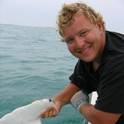
- herbivory,
- predation risk,
- green turtle,
- seagrass,
- behaviorally mediated indirect interaction,
- stoichiometry,
- shark,
- dugong,
- stable isotope,
- exclosure
The loss of large-bodied herbivores and/or top predators has been associated with large-scale changes in terrestrial, freshwater, and marine ecosystems around the world. Understanding the consequences of these declines has been hampered by a lack of studies in relatively pristine systems. To fill this gap, I investigated the dynamics of the relatively pristine seagrass ecosystem of Shark Bay, Australia. I began by examining the seagrass species distributions, stoichiometry, and patterns of nutrient limitation across the whole of Shark Bay. Large areas were N-limited, P-limited, or limited by factors other than nutrients. Phosphorus-limitation was centered in areas of restricted water exchange with the ocean. Nutrient content of seagrasses varied seasonally, but the strength of seasonal responses were species-specific. Using a cafeteria-style experiment, I found that fast-growing seagrass species, which had higher nutrient content experienced higher rates of herbivory than slow-growing species that are dominant in the bay but have low nutrient content. Although removal rates correlated well with nutrient content at a broad scale, within fast-growing species removal rates were not closely tied to N or P content. Using a combination of stable isotope analysis and animal borne video, I found that green turtles (Chelonia mydas) – one of the most abundant large-bodied herbivores in Shark Bay – appear to assimilate little energy from seagrasses at the population level. There was, however, evidence of individual specialization in turtle diets with some individuals foraging largely on seagrasses and others feeding primarily on macroalgae and gelatinous macroplankton. Finally, I used exclusion cages, to examine whether predation-sensitive habitat shifts by megagrazers (green turtles, dugongs) transmitted a behavior-mediated trophic cascade (BMTC) between sharks and seagrasses. In general, data were consistent with predictions of a behavior-mediated trophic cascade. Megaherbivore impacts on seagrasses were large only in the microhabitat where megaherbivores congregate to reduce predation risk. My study highlights the importance of large herbivores in structuring seagrass communities and, more generally, suggests that roving top predators likely are important in structuring communities - and possibly ecosystems - through non-consumptive pathways.
Available at: http://works.bepress.com/derek-burkholder/5/
